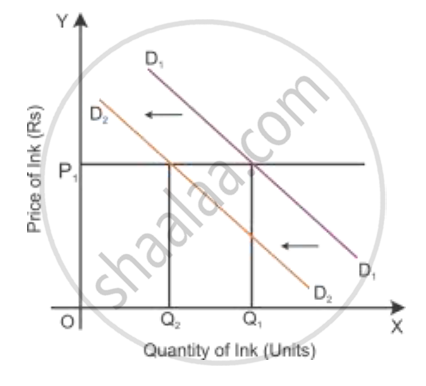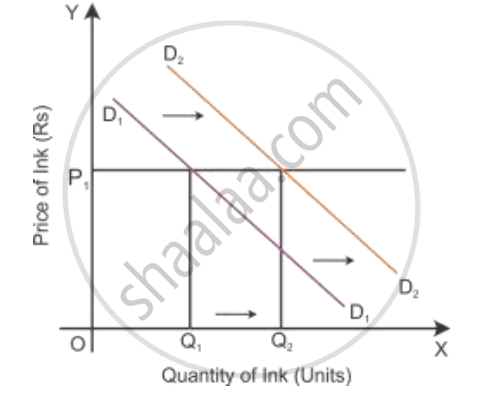Advertisements
Advertisements
प्रश्न
How does change in the price of complementary good affect the demand for the given good? Explain with the help of an example.
उत्तर
Demand for a commodity in relation to the price of the complementary good
Complementary goods are purchased jointly such as ink and ink pens.
Increase in price of the complementary good:
If there is an increase in the price of a good, then the demand for another good will decline. So the demand curve shifts parallel to the left, i.e. from D1D1 to D2D2

A decrease in the price of the complementary good:
If there is a decrease in the price of a good, then the demand for another good will increase. So the demand curve shifts parallel to the right, i.e. from D1D1 to D2D2.

APPEARS IN
संबंधित प्रश्न
Explain any two factors that affect the price elasticity of demand. Give suitable examples.
When price of a commodity falls by Rs 1 per unit, its quantity demanded rises by 3 units. Its price elasticity of demand is (−) 2. Calculate its quantity demanded if the price before the change was Rs 10 per unit.
Match the following :
| Group 'A' | Group 'B' |
| (a) Demand and price | (1) wages |
| (b) Perfectly elastic supply | (2) Vertical supply curve |
| (c) Land | (3) Transfer income |
| (d) Unemployment allowance | (4) Horizontal supply curve |
| (e) Reserve Bank of India | (5) Inverse relation |
| (6) Rent | |
| (7) 1935 | |
| (8) Direct relation |
State whether the following statement is true or false :
Concept of ‘elasticity of demand’ is useful for the finance minister.
Write Short note on the following.
Ratio method of measuring price elasticity of demand ?
Choose the correct answer :
Demand of electricity for domestic purpose is _________.
Choose the correct answer :
The account in which the specific amount is deposited per month regularly is known as _________.
Match the following:
|
Group A
|
Group B
|
|
1. Cars and petrol
|
a. Elastic demand
|
|
2. Point method
|
b. Complementary
|
|
3. Necessary goods
|
c. Geometric method
|
|
|
d. Inelastic demand
|
The coefficient of price elasticity of demand for Good X is (−) 0.2. If there is a 5% increase in the price of the good, by what percentage will the quantity demanded for the good fall?
State whether demand will be Elastic or Inelastic. Give reasons for your answer.
The demand for salt by households.
Elasticity of demand for two goods A and B is -2 and -3 respectively. Then good A has higher elasticity.
The price of Y falls from ₹ 8 to ₹ 6. The quantity demanded increases from 100 units to 125 units. The price electricity of demand will be ______.
Which of the following is the most likely reason for the relatively high elasticity of bottled water?
Assertion (A): The demand for soap, salt, matches etc. is highly elastic.
Reason (R): The demand for soap, salt, matches etc. is highly inelastic because the consumer spends a very small amount of expenditure in relation to his/her income.
Assertion (A): Demand for a commodity with large number of substitutes with be less elastic.
Reason (R): With large number of substitutes, even a small rise in its price will induce the buyers to go for its substitutes.
Comment upon the shape of the demand curve, if Ed = 0.
How does the nature of a commodity affect its price elasticity of demand?
